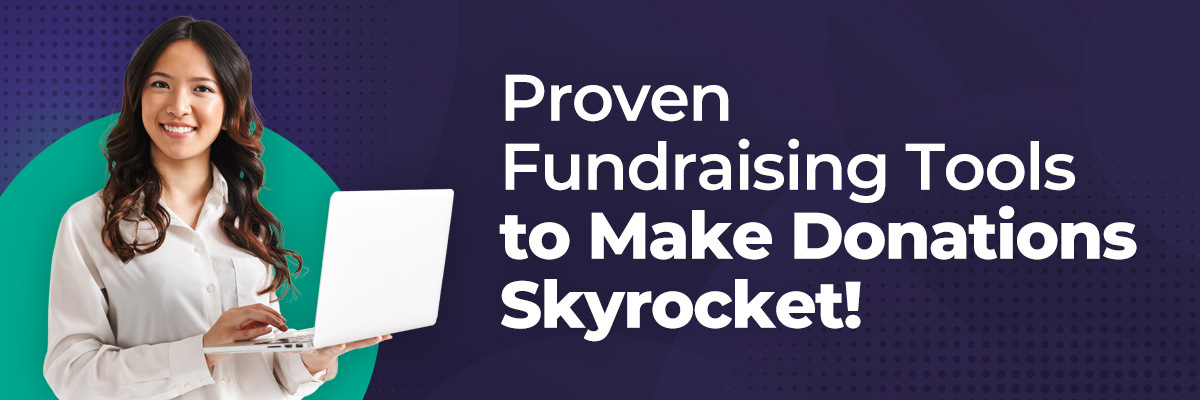
Fundaising is a crucial component of success for any nonprofit - but it's not easy to achieve and maintain fundraising success. In order to build a faithful base of support, nonprofits need to develop and execute campaigns that engage supporters and build relationships that go beyond merely giving money to their cause. Below, you'll find an in-depth guide to creating and executing fundraising campaigns that power your nonprofit to do even more good for those you serve.
Table of Contents
- What is a Fundraising Campaign
- The Importance of Strategic Campaign Planning
- Types Of Fundraising Campaigns
- Best Practices to Raise More for Your Cause
- FAQs
- What is a Nonprofit Fundraising Strategy?
- How Do I Create a Fundraising Strategy for My Nonprofit?
- How Can I Set Realistic and Achievable Fundraising Goals?
- How Do I Craft a Message That Resonates with Potential Donors?
- Which Digital Platforms Are Best for Online Fundraising?
- How Do I Measure the Success of My Fundraising Campaigns?
- 100+ Free Tools & Templates to Help with Your Fundraising Campaign
What is a fundraising campaign?

A fundraising campaign isn't merely soliciting funds; it's a detailed endeavor to create awareness for a project or goal. It is much like telling a story from your organization, intending to arouse action in people. A campaign for fundraising brings the mission to life and makes it more appealing to people interested in making a difference.
As a nonprofit, you don't just measure success in terms of dollars raised through a campaign. You also measure how much trust it builds, how many more relationships it nurtures, and how clearly it shows to the donors the real-life effects of their support.
From Giving Tuesday events to crowdfunding campaign efforts, there are endless possibilities for running a campaign. The primary goal is discovering what works for your audience and your mission.
This article contains techniques that work for running a successful fundraising campaign. Here, you learn how to approach planning, credibility building, and meaningful engagement with your supporters.
If you are new to fundraising or want some improved tips to inspire more donors and make sustainable changes, the tips in this article will help you do so. Now, let us make your next campaign the most successful yet!
The Importance of Strategic Campaign Planning
Strategic planning is a vital part of your fundraising success. Nonprofits that have a written strategic plan tend to thrive. It's not rocket science; a nonprofit with written plans is better positioned for collaborations, has stronger boards, and takes risks that drive it toward growth.
In addition, they tend to have formal processes for tracking leadership effectiveness. Strategic planning isn't only about making a document; it's about having and executing a plan with the team.
Research shows that organizations with a plan are around 30% more likely to grow and obtain funding much better than those without a strategic direction. Furthermore, it has been found that 71% of rapidly growing organizations have a strategy plan in place. That is the direct link between planning and success.
The statistics mean improved donor engagement for nonprofits that prioritize strategic planning. Better-defined goals improve resource allocations, which invariably translates into optimum retention and contribution by donors. Indeed, proper planning critically impacts any fundraising campaign.
It makes it efficient and purposeful. Also, it increases the likelihood of achieving or surpassing set financial targets. Setting objectives and using a systematic process enables nonprofits to have an increased impact on fundraising and building durable relationships with donors.
Types Of Fundraising Campaigns
Giving Tuesday Campaign
Giving Tuesday is a global giving day after Black Friday and Cyber Monday. Nonprofit organizations must rally their potential donors into giving, volunteering, or spreading the word about their cause. A Giving Tuesday campaign uses social media, email solicitations, and other digital outlets to get people to give.
The success of these campaigns is driven, as is so often the case, simply by urgency and collective action, exploiting the holiday spirit of generosity. And it doesn't hurt when there is strategic use of matching gifts, influencer partnerships, or storytelling power in the mix.
Advocacy Campaign
Advocacy campaigns usually target influence in public policy, legislation, or awareness of an issue. It's not just for fundraising purposes but also an avenue to encourage supporters to take grassroots action, such as signing petitions, contacting lawmakers, or attending a rally.
Nonprofits benefit from the visibility—they build long-term momentum and deeper community engagement. Advocacy campaigns showcase the importance of a cause and its societal impact. Success is determined by sounding stories, strategic alliances, and digital and grassroots mobilization.
Awareness Campaign
An awareness campaign is designed to sensitize people concerning a matter or cause. It can be a broad campaign that strives to reach the maximum number of individuals or a focused one aimed at specific individuals who can bring change.
Social media, public service announcements, community events, and informational resources are often the lines for such campaigns. The targets include visibility, understanding, getting people involved, donating, or changing behaviors.
Strong storytelling, eye-catching visuals, and impactful statistics convey the importance of the issue at hand.
Annual Giving Campaign
Annual giving campaigns are usually yearly fundraising campaigns to encourage donors to be active in giving financial support. These campaigns are vital resources for a steady cash flow and are typically associated with more personalized outreach.
They can be through direct mail, email, or an event. Annual giving campaigns provide organizations a platform to reconnect with former donors, recognize donors’ contributions, and renew support for continued programs.
A successful campaign can increase the retention rate among donors and ensure total funding for an organization's programs.
Text-To-Donate Campaign
Text-to-donate campaigns offer an easy mobile means for donors to give by simply texting the keyword to a number. Such campaigns are perfect for time-bound events, like disaster relief or urgent appeals.
The great simplicity of texting makes it easy for people to donate on the go or when they are away from home, which increases participation. Such campaigns are usually expected to integrate with mobile donation platforms, making it easier and faster for the donor to donate.
Clear messages and strong calls to action are essential since these will encourage such supporters to understand how to give and the cause for which they are providing.
Social Media Campaign
Social media digital fundraising campaigns use platforms like Facebook, Instagram, X, and TikTok to reach supporters, create awareness, and raise funds. It uses viral content, challenges, hashtags, and influencers to get as many people as possible.
Social media creates a space where nonprofits can present compelling, easily shareable content requiring supporters to advocate for the cause. Success depends on crafting entertaining, shareable posts and engaging followers in the community through interaction to form a culture around the campaign.
Peer-To-Peer Fundraising Campaign
In a peer-to-peer fundraising campaign, donors raise funds on behalf of an organization by using peer connections. It usually consists of a fundraising page where one can raise funds from friends, family, and colleagues.
It’s an excellent way to expand your donor base and engage people on a personal level. These campaigns mainly depend on the excitement and enthusiasm of the participants.
Crowdfunding Campaign
Still, crowdfunding is another approach to raising money for a nonprofit. Crowdfunding campaigns allow people or organizations to raise sums of money small enough to be raised by many people via online platforms like GoFundMe, Kickstarter, or Indiegogo.
Nonprofits often arrange crowdfunding to raise funds for a specific project, an immediate need for disaster relief, or money for a new program. The success of a crowdfunding campaign lies in telling a story that is very emotional and compelling enough to inspire donors to give. Peer-to-peer and social media sharing greatly influence campaign dissemination and reach.
Best Practices to Raise More for Your Cause
Leverage Social Proof
Social proof is a prominent tool for developing trust and motivating donations. Highlighting successful campaigns inspires others and opens a proven path to what's possible.
For example, if a fundraising campaign exceeded its target and made a substantial difference in the community, tell that whole story with specifics—the dollar amount raised, the number of people involved, and the change made.
A thriving testimonial from a donor or beneficiary would be touching, most likely reinforcing the idea that your nonprofit shows results. Include these in email campaigns, social media posts, and donation pages to illustrate widespread community support.
Maintain Transparency in Financial Reporting
Donor trust is built and preserved through transparency. Give a specific breakdown of how donations directly affect your mission. For example, 80% of funds go directly to programs, and 20% support operational costs. Add visual aids such as infographics or progress bars to your website or campaign page that make this information accessible.
Additionally, send major donors detailed reports or updates showing how many milestones have been achieved from their contributions.
Regular Donor Updates
Providing major donors with all the necessary information develops strong relationships over time. Provide frequent updates regarding programs and accomplishments through newsletters, emails, and social media. Tell a personal story with photos and videos that show how the donors have made a difference.
For example, a video featuring a family that has benefited from a food drive or visits to a school supported by a scholarship goes a long way. Such updates make donors feel appreciated and reaffirm their decisions about giving to your cause, increasing the likelihood of ongoing involvement.
Incorporate Peer-to-Peer Fundraising
Peer-to-peer fundraising lets your loyal supporters spread the word about your campaign by tapping into their networks. Equip them with fundraising tools such as customizable fundraising pages, social media templates, and email scripts to help them tell others about your cause. This method raises further funding and exposes your organization to new audiences.
For instance, a supporter could start a birthday fundraiser and ask friends and family for donations rather than gifts. Show off these inspirational successes by showing how to raise money and encourage others to do the same.
Form Strategic Corporate Partnerships
Partner with other businesses to tremendously enhance your campaign's visibility and contributions. You can partner with local or prominent companies for sponsorships, matched donations, and co-branded events.
Don’t forget to show the companies how they will benefit from the partnership. Corporate partners potentially gain more publicity and goodwill from the community, while your nonprofit gets monetary support and broader reach.
Personalize Donor Interactions
Personalization works a lot in cultivating donor loyalty. Send personalized thank-you notes, recognizing individual donation and their impact. Use donor segmentation for targeted appeals based on giving patterns or interests.
For example, long-term supporters might receive exclusive invitations to a virtual event, while first-time donors would get a welcome kit. Such little gestures show the donor they're noticed and valued.
Host Engaging Virtual or In-Person Events
Fun events are an excellent way to engage your donor base and create a sense of community. Host virtual and in-person gatherings with features such as interacting activities, guest speakers, or live entertainment that keep them invested in your cause.
For instance, it may be an in-person gala with live music; this event can be fun and impactful. Use these events to convey success stories, draw attention to the importance of your mission, and encourage attendees to give further.
Promote Recurring Donation Options
Recurring donations are a steady funding stream, making planning and maintaining programs simple. Establish a subscription-like model, such as monthly or annual giving. It makes giving a whole lot more seamless to you and the donors.
A little incentive like special communications or tiny tokens of thanks may encourage participation. You could try a “monthly donor club” that provides behind-the-scenes looks at how your nonprofit did its work.
Optimize Your Campaign with Data Insights
Decisions based on data can help fundraisers find ways to raise money. Campaign performance can be tracked through analytics, providing insight into donor behaviors.
KPIs, or key performance indicators such as conversion rates, average donor size, and donor retention rates, significantly inform the process. To illustrate, if a particular email series performs with higher engagement, replicate the email series format again in future campaigns.
You must keep reviewing your strategies, updating your tactics in real-time, and learning from your past campaigns to improve future efforts.
FAQs
What is a Nonprofit Fundraising Strategy?
A nonprofit fundraising strategy is a comprehensive scheme used to mobilize resources, especially finances, to facilitate the mission and programs of an organization. It outlines the plan for identifying potential donors, engaging current supporters, and targeting various revenue-generating channels.
This strategy includes setting campaign goals for your organization, identifying and understanding the target audience, and carrying out campaigns that achieve your objectives. Effective strategies also provide metrics for measuring success over time—they are designed with donor behavior in mind and room for flexibility.
A good plan will result in sustainable involvement, growth, and the development of relationships over the long haul.
How Do I Create a Fundraising Strategy for My Nonprofit?
A successful fundraising strategy begins with setting clear goals. Specify the funds needed and where they will go—operating costs, a new initiative, or service expansion. Furthermore, the current donor base and potential audiences should be assessed to develop new targeted campaigns.
Use a combination of methods such as events, online campaigns, corporate partnerships, or grants. It also helps to create a timetable that outlines activities and allocates tasks to team members. CRM software will also help manage and monitor donor interactions.
Continually evaluate and update the strategy regarding effectiveness to remain amenable to changing situations.
How Can I Set Realistic and Achievable Fundraising Goals?
A perfect way to achieve fundraising goals is by looking at your organization's past fundraising performance so that you may have realistic goals. Consider donor capacities, current economic realities, and existing resources when setting goals.
Divide significant goals into smaller practical target goals. For example, if your annual target is $100,000, you'd break it down into a quarterly target of $25,000.
Setting SMART goals—Specific, Measurable, Achievable, Relevant, and Time-bound—will ensure transparent and accountable efforts that align with your mission.
How Do I Craft a Message That Resonates with Potential Donors?
Developing a strong message can go a long way towards donor engagement. Tell stories of how the donations impact; include tangible instances or testimonies from the beneficiaries. Creatively publicize your mission and present a sense of urgency.
Then, personalize messages based on donor demographics and inclinations. For example, younger audiences might find social media updates appealing, while older donors often prefer lengthier messages conveyed through email or even direct mail.
Always have a solid call to action, such as "Donate now to provide meals for 100 families," to make that action easy for donors to do at the moment.
Which Digital Platforms Are Best for Online Fundraising?
Online fundraising platforms come in various types and are suitable for different purposes. If you're interested in a particular specific campaign, crowdfunding sites like GoFundMe or Classy work great.
Alternatively, Facebook fundraisers allow social sharing and peer-to-peer giving. Mobile applications, such as Vanco's text-to-give and other donation services, are also designed to support online giving.
How Do I Measure the Success of My Fundraising Campaigns?
Success can be measured using key performance indicators, such as total funds raised, donor retention rates, average gift size, etc. Other tools include Google Analytics and fundraising software that provides further insight into donor behaviors and campaign performance.
Engagement metrics such as email open rates, social media shares, and event attendance can be assessed.
100+ Free Tools for Nonprofits to Inspire Unprecedented Generosity!
We’ve put together 100+ pro tools and templates that are guaranteed to boost your nonprofit’s fundraising—no guesswork, no fluff. Here’s what’s inside:
- Word-for-word fundraising scripts that turn "no" into "yes"
- Fundraising letter, email and thank you templates for every situation.
- Event planning and evaluation tools including checklists, reports, evaluations, surveys and more
- Plug-and-play sponsorship proposals and templates sponsors can't resist
- Free design materials that make your events look professional
- Donation Receipt Templates for every type of contribution
- 7 AI bots to handle repetitive tasks and save you hours
The only question left: Are you ready to turn the chaos into success?
Act now!
5 Minutes to Fundraiser Success: The No-Hassle, Risk-Free Event Management Option for Nonprofits

Imagine setting up your next fundraising event in just five minutes. That’s what Vanco does for you—no learning curve, just a quick setup and an easy, intuitive system. You can try it risk-free and discover what thousands of nonprofits already know: event management doesn’t have to be a chore.












